Need Advice on Valve Cover
|
I submit to the Mahal gods, a bit of a dilemma.
I took off the driver side valve cover today to address a SMALL oil leak which I think was at the back. The inside of the cover and the heads all look really clean—no sludge. Got it off, stripped the paint, cleaned it up, and found rust at the back where I think the leak is from. The bolt was rather soaked in oil as well on the outside. The rust is mostly outside the cover, but I found a pin hole in the rail. I check for true only by placing it on the cement garage floor. It rocks slightly. I need to check more thoroughly though. OK, so, should I use this, or does the rust/hole suggest I get a new set? Pics follow:  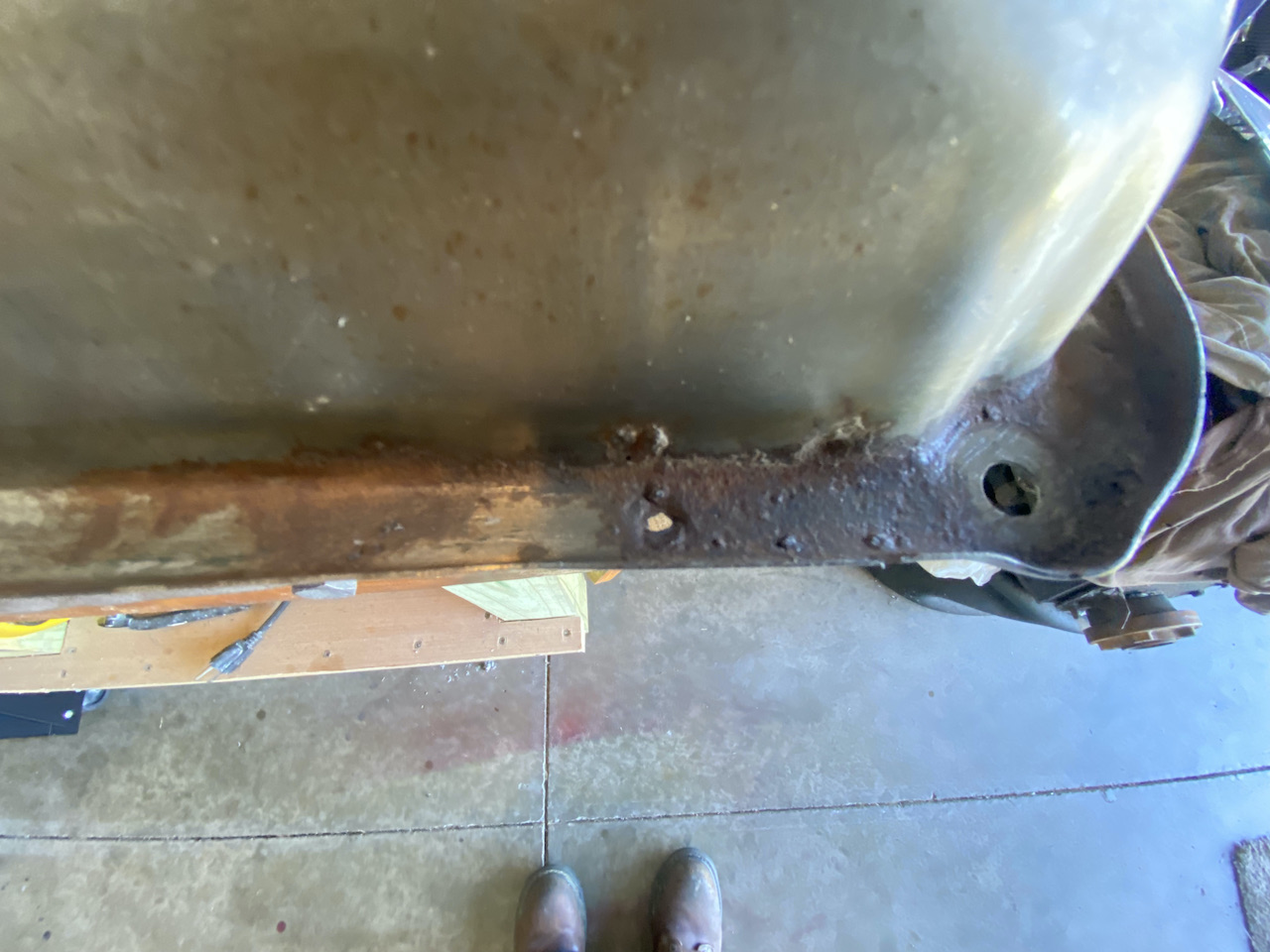 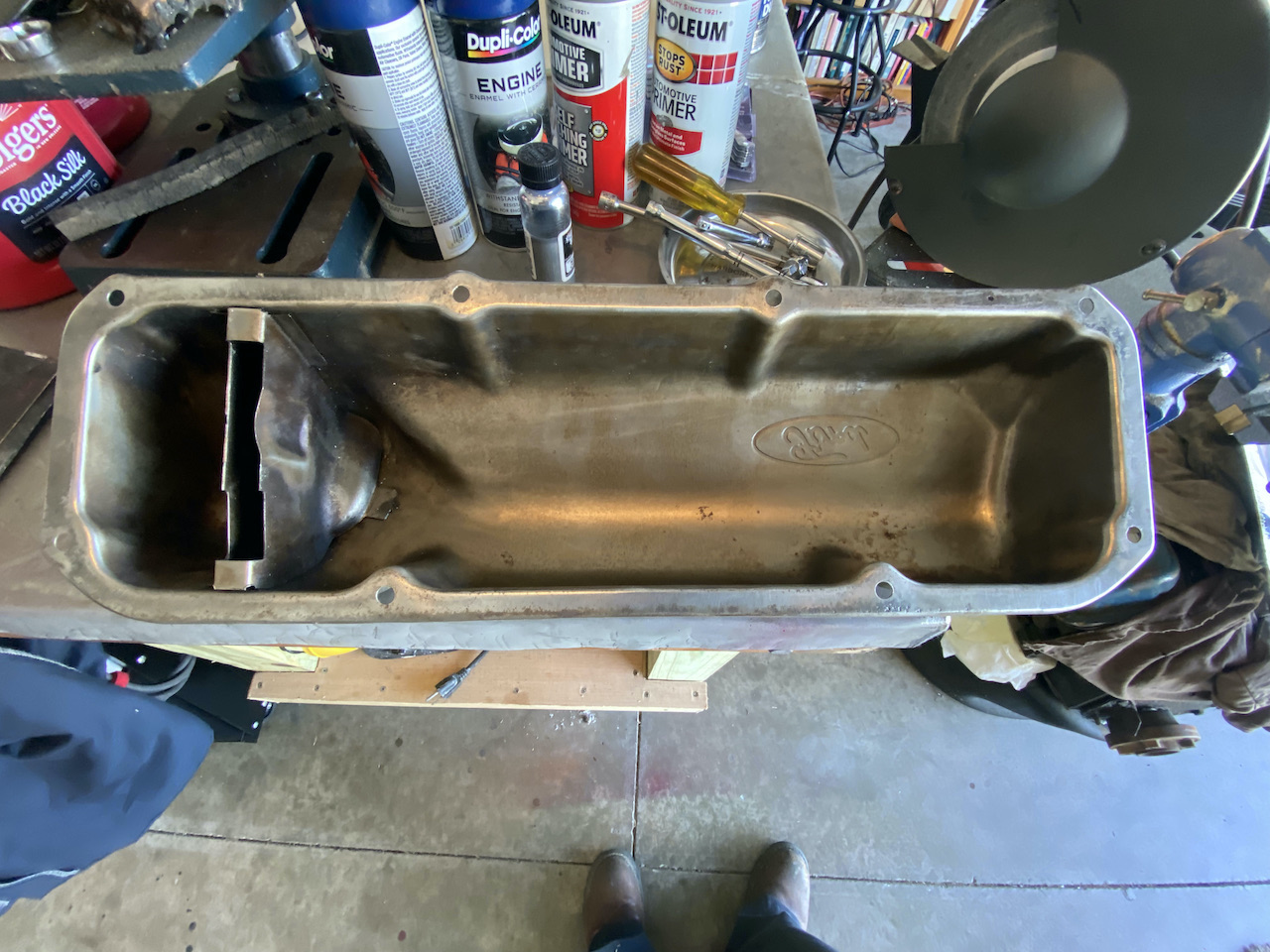
1980 Ford XLT F350
400 Engine (rebuilt to 406) Holley 2300 500 CFM manual Choke Carb Under Restore (1st time) |
|
Administrator
|
It looks like someone tried to weld it up. There seems to be welding spatter on it near the hole. Right?
And the hole goes through where the gasket goes, so in theory shouldn't leak. But something has been leaking, and probably though that hole? My first thought was to replace the valve cover, but on second thought how could it leak through that hole since the gasket will be there? 
Gary, AKA "Gary fellow": Profile
Dad's: '81 F150 Ranger XLT 4x4: Down for restomod: Full-roller "stroked 351M" w/Trick Flow heads & intake, EEC-V SEFI/E4OD/3.50 gears w/Kevlar clutches
|
Re: Need Advice on Valve Cover
On the outside, yes, that DOES look like splatter. And they tried to weld despite the rust? [insert face plant emoji here]🤬 I wanted to keep it because of the Ford stamping. Was going to go back to blue (it was repainted black), and outline the letters in silver. But, I’d rather do this right.
1980 Ford XLT F350
400 Engine (rebuilt to 406) Holley 2300 500 CFM manual Choke Carb Under Restore (1st time) |
|
Administrator
|
I would have brazed it. In fact I have brazed valve covers. So if you can clean off the spatter and rust you could braze the hole shut and know it won't leak.
Gary, AKA "Gary fellow": Profile
Dad's: '81 F150 Ranger XLT 4x4: Down for restomod: Full-roller "stroked 351M" w/Trick Flow heads & intake, EEC-V SEFI/E4OD/3.50 gears w/Kevlar clutches
|
|
Administrator
|
It's a good approach.
Brass or bronze can't ever rust again. 
Jim,
Lil'Red is a '87 F250 HD, 4.10's, 1356 4x4, Zf-5, 3G, PMGR, Saginaw PS, desmogged with a Holley 80508 and Performer intake. Too much other stuff to mention. |
Re: Need Advice on Valve Cover
|
This is all great advice. I would use SSf-6, but oy, the price of that. a small 1/16 rod with flux I may try...but will it hold to all that rust?
1980 Ford XLT F350
400 Engine (rebuilt to 406) Holley 2300 500 CFM manual Choke Carb Under Restore (1st time) |
|
please remove all rust. otherwise, it may corrode under your repair.
|
|
Administrator
|
In reply to this post by AmericanSavage
Oy? If I remember right Mick said that at the end of 19th Nervous Breakdown.
 Man, that takes me BACK! Not only to the 60's but the two years we spent in the UK. Oy! Anyway, yes you need to clean off the rust. Get down to bare metal and use a flux brazing rod or a brazing rod dipped in flux. It'll flow nicely on the bare steel and fill that hole. Plus you can easily file it back smooth.
Gary, AKA "Gary fellow": Profile
Dad's: '81 F150 Ranger XLT 4x4: Down for restomod: Full-roller "stroked 351M" w/Trick Flow heads & intake, EEC-V SEFI/E4OD/3.50 gears w/Kevlar clutches
|
Re: Need Advice on Valve Cover
|
Did a little muriatic around the hole after sand sand sand. Here is the bronze filling the hole. I need to Phos or Muriatic the rest. Not sure this will repair it—rust never sleeps—but will likely rust reform the other areas, then, shooting the primer….
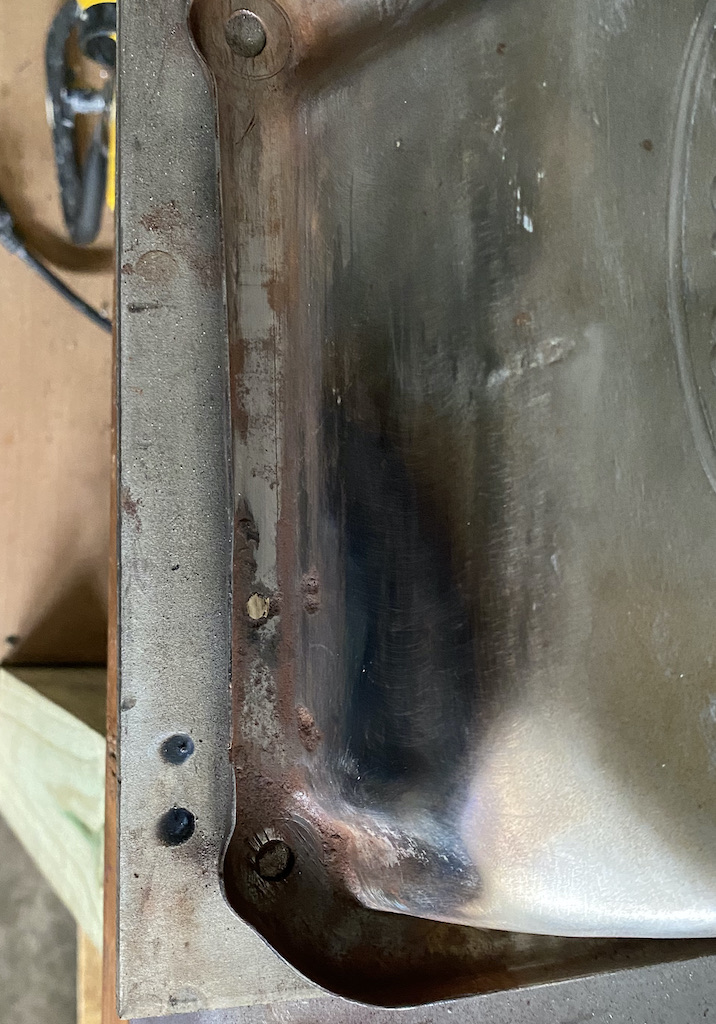
1980 Ford XLT F350
400 Engine (rebuilt to 406) Holley 2300 500 CFM manual Choke Carb Under Restore (1st time) |
|
Administrator
|
Stay away from the hydrochloric if you can.
Chlorine remains corrosive (in fact, it's probably sodium chloride that started the problem
Jim,
Lil'Red is a '87 F250 HD, 4.10's, 1356 4x4, Zf-5, 3G, PMGR, Saginaw PS, desmogged with a Holley 80508 and Performer intake. Too much other stuff to mention. |
|
Administrator
|
In reply to this post by AmericanSavage
I think you got the hole filled and smoothed off nicely.

Gary, AKA "Gary fellow": Profile
Dad's: '81 F150 Ranger XLT 4x4: Down for restomod: Full-roller "stroked 351M" w/Trick Flow heads & intake, EEC-V SEFI/E4OD/3.50 gears w/Kevlar clutches
|
Re: Need Advice on Valve Cover
|
Here’s the update after the Muriatic bath, and then neutralized
Also someone mentioned hydrochloric—I only ever use Phosphoric, and more recently have experimented with Muriatic (it’s quicker, but also less forgiving). If not neutralized, it will rust worse than before within 24 hours. But it is way more powerful: BTW, thanks Gary! Took a couple of tries and playing with the heat! 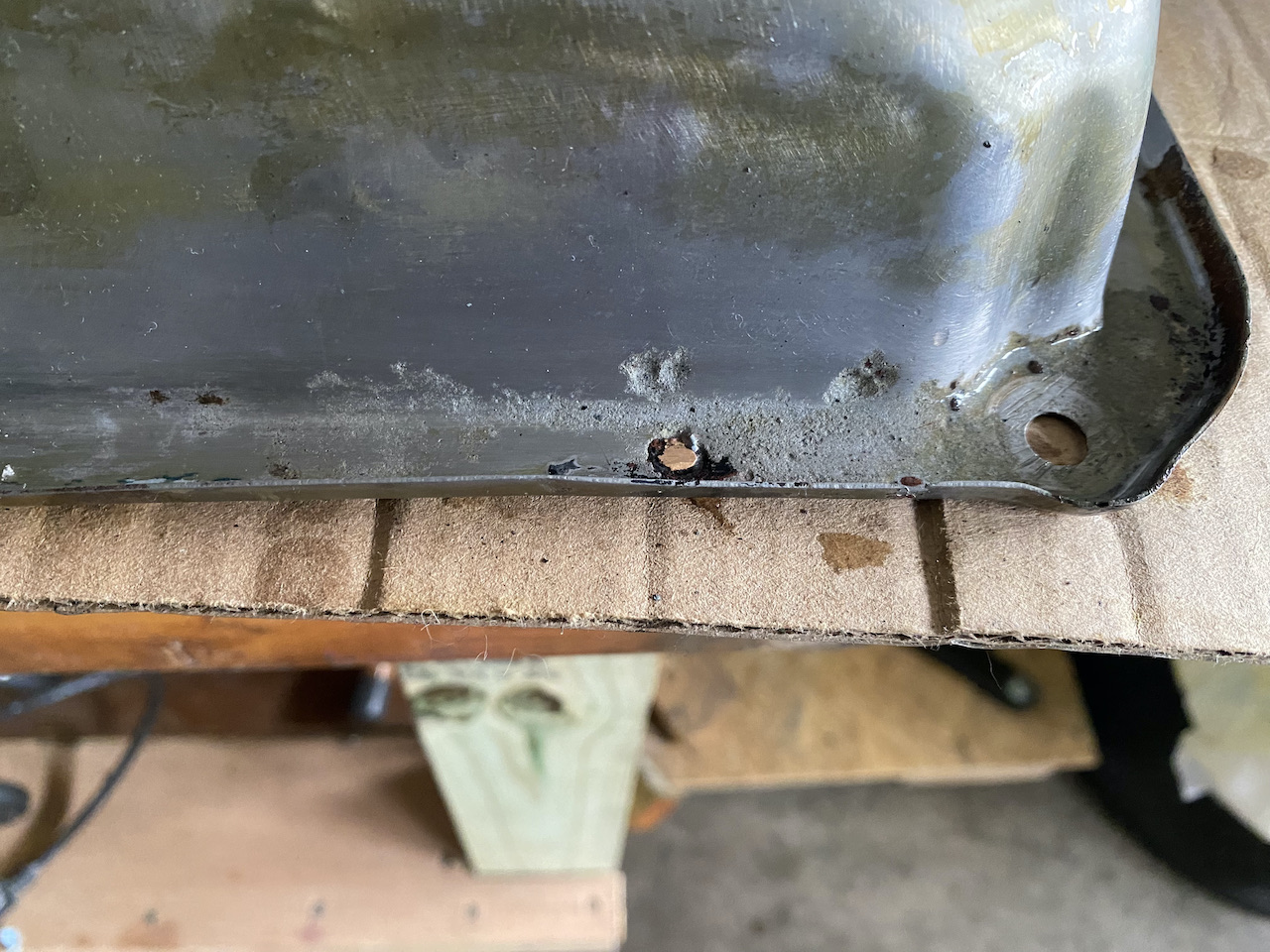
1980 Ford XLT F350
400 Engine (rebuilt to 406) Holley 2300 500 CFM manual Choke Carb Under Restore (1st time) |
|
Administrator
|
Muriatic IS Hydrochloric.....
Do you ever read the label, so you can understand what kind of dangerous stuff you're dealing with? 
Jim,
Lil'Red is a '87 F250 HD, 4.10's, 1356 4x4, Zf-5, 3G, PMGR, Saginaw PS, desmogged with a Holley 80508 and Performer intake. Too much other stuff to mention. |
Re: Need Advice on Valve Cover
Thanks for your concern: you do understand that they call it muriatic because it is not 100% hydro, yes? The stuff is pretty well cut over the counter, to lessen the effect of the more pure/stronger stuff. Therefore, your assertion they are = to each other is not true. Here are the facts: Main Difference – Hydrochloric Acid vs Muriatic Acid An acid is a chemical compound having characteristic properties such as turning blue litmus red, neutralizing alkali solutions and corrosiveness. Hydrochloric acid is a strong acid compared to other acids. People often confuse Muriatic acid with hydrochloric acid, assuming that both are the same; however, there is a slight difference between hydrochloric acid and Muriatic acid. The main difference between hydrochloric acid and Muriatic acid is that hydrochloric acid is composed of only HCl molecules whereas Muriatic acid is composed of impurities along with HCl molecules. And yes I do. That is why I have used it as prescribed open and ventilated. You should check out the body shops that use it. It's impressive.
1980 Ford XLT F350
400 Engine (rebuilt to 406) Holley 2300 500 CFM manual Choke Carb Under Restore (1st time) |
|
Administrator
|
This post was updated on .
Do you understand that chlorine is a stronger oxidizer than oxygen?
And what about it makes it so toxic and corrosive? You're trying to remove rust, which was likely caused by sodium chloride. Another chlorine compound. And why??? Because chlorine corrosion does not leave a passivated surface..... 💡 Edit; 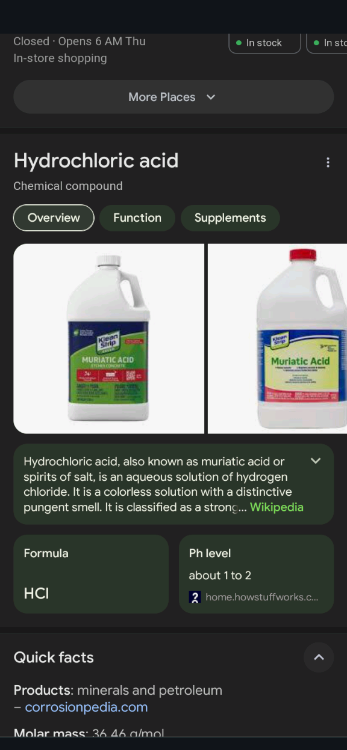
Jim,
Lil'Red is a '87 F250 HD, 4.10's, 1356 4x4, Zf-5, 3G, PMGR, Saginaw PS, desmogged with a Holley 80508 and Performer intake. Too much other stuff to mention. |
Re: Need Advice on Valve Cover
Do you understand the chemical make up of the each is different?—that is why one is called hydro and the other mur. To equate them is false. Even in you own post, demonstrates my point—“also known as” is not the same as “identical.” I have no idea why this is an issue for you. But I posted the fact, of the compound. Whether you choose to accept that is up to you. As to the why: take it up with the many serious body shops that use it when necessary. They will tell you the why. It is used especially on older 50s panels they are seeking to save. If you seek them out, you will learn the why.
1980 Ford XLT F350
400 Engine (rebuilt to 406) Holley 2300 500 CFM manual Choke Carb Under Restore (1st time) |
|
Administrator
|
Yeah, I'm done
Good luck! 🙂
Jim,
Lil'Red is a '87 F250 HD, 4.10's, 1356 4x4, Zf-5, 3G, PMGR, Saginaw PS, desmogged with a Holley 80508 and Performer intake. Too much other stuff to mention. |
Re: Need Advice on Valve Cover
Thanks for your input. For those interested in the factual (scientific and widespread) use of the product, here is ONE example. When you get to rust that has been embedded, and maybe even has caused some serious pitting, Muriatic is the only option. Great guy.
1980 Ford XLT F350
400 Engine (rebuilt to 406) Holley 2300 500 CFM manual Choke Carb Under Restore (1st time) |
|
This post was updated on .
Thanks for the share.
A good portion of my job involves corrosion prevention in PCBs and substrates used in semiconductors. Over there you deal with Copper, Aluminum, not steel, but the principles are similar. HCL, often in combination with H2O2 is typically used to etch metal. If metal oxides only are to be removed then, other acids like H2SO4, H3PO4, but of course generally we don't deal with pitting etc in copper traces, if there is any pitting at all, the trace is too narrow to still be usable. I can see your approach working well here using muriatic, it will definitely do the best job of etching it and with a good job of neutralize it and rinsing it to remove all resides, and then passivating it with paint, I can see it working well. About Chlorine, in semiconductors we avoid residues of it like the plague, as it is by far the worst catalyst for long-term corrosion even in ppm levels (galvanic or electrochemical or just environmental corrosion which is most applicable for automobiles). Again, with a good rinse (ideally with deionized water like it is done in PCB/substrate manufacturing because it is more likely to attract any ions) I can see it working well especially on something that will be painted well. I wanted to suggest another approach I found recently which involves media blasting to remove all pitting. In your case that would be wonderful as you are only trying to cover a very small area. After that you can simply finish it off with paint and be done. I recently tried that in my post below https://forum.garysgaragemahal.com/460-swap-into-a-78-Bronco-tp148376p149892.html
Vivek
- 'Big Blue 2WD' - 1984 F350 RWD 460/C6 - 1978 Bronco with the heart of a 1986 F250 Bullnose - under restoration - "Bonded Bronco" -1985 Bronco - 302 4-speed fuel injected, Hibernating future project |
Re: Need Advice on Valve Cover
|
This post was updated on .
This is EXCELLENT viven44. I learned something i did not know from it. I will be checking out your link. Cheers! Read your link: Ospho is fabulous, and I certainly have used it. It can be used after Muriatic on difficult jobs, and that is beneficial. Generally speaking it works great on rusty sheet metal, and it does need to be neutralized as some paints do not like it. Certainly the gooey stuff it sometimes creates, needs cleaning. I thought you did a great job on that cab floor.
1980 Ford XLT F350
400 Engine (rebuilt to 406) Holley 2300 500 CFM manual Choke Carb Under Restore (1st time) |
| Edit this page |

